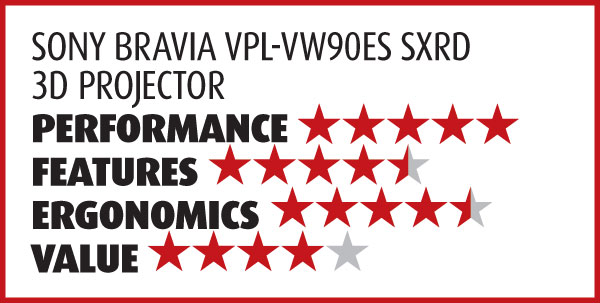Sony BRAVIA VPL-VW90ES SXRD 3D Projector Page 3
3D Performance
The inevitable loss of brightness with 3D playback is a significant negative with the Sony projector. But this has been the case with most of the affordable 3D displays I’ve seen. If you demand a screen significantly larger than 84 to 96 inches wide, be prepared for a dim 3D picture with this or any but the most expensive 3D projectors. An ultra-high-gain screen is another solution, but only if you’re prepared for the 2D performance compromises that come with a high-gain screen.

That caveat aside, the Sony’s 3D performance was as effective as any I’ve seen. The 3D titles I sampled or watched in their entirety on the VPL-VW90ES included four titles that I reviewed for Home Theater: Clash of the Titans, A Christmas Carol, Legend of the Guardians: The Owls of Ga’Hoole, and Despicable Me. Throw in Monsters vs. Aliens, Alice in Wonderland, and Avatar, and you have a good representation of current 3D source material (although some of these movies are still available in 3D only to buyers of a specific HDTV—grrr).
All of these titles produced effective 3D images on the Sony, although they varied wildly in other respects. Alice looked dreadful—much as I remember it from the theater—with washed-out and weirdly skewed colors. Titans was better, but not by much. Despicable Me and Monsters vs. Aliens were solid performers, since both of them are fairly bright. Oddly enough, Owls and Carol worked for me as well, despite the fact that both have more than a few very dark sequences.
Avatar was an interesting case. It looked as good or better in 3D than any of the other titles. But the 2D version jumped off the screen in a way that the 3D did not, with more vivid colors and enhanced overall contrast. The 2D Avatar also had a natural dimensionality on the Sony. If that dimensionality didn’t quite generate the “wow” reaction that true 3D can produce, it was nevertheless compelling. If I had to choose between experiencing this film in 2D or 3D on the Sony, I might very well choose 2D.
For most of my 3D viewing (and all of the settings you’ll find in the online posting of this review at HomeTheater.com), I used Sony’s Standard Picture Mode for its high brightness. However, just before deadline, I overcame my natural aversion to even considering the Dynamic mode and tried it. It did up the brightness another small but worthwhile notch, with no obvious visible negatives.
I saw some ghosting or crosstalk on the Sony, but no more than I’ve experienced with other LCD and LCOS 3D displays. It wasn’t serious enough to put me off the 3D experience. The only affordable 3D displays I’ve seen with less crosstalk have been Panasonic plasmas (we have not yet tested a popularly priced DLP 3D projector). Unlike with most flat-panel displays, you can tilt your head while viewing 3D on the Sony without seeing either ghosting or a dimmer image.
Comparisons and Conclusions
While I didn’t have another comparably priced competitor on hand, I did have a sample of the $4,495 JVC DLA-X3 in house. This was a different sample than the one Kris Deering reviews elsewhere in this issue. I made the comparisons here in 2D.
Despite the price difference, the results were initially closer than you might expect after I’d matched the two projectors’ setups as closely as their controls would allow. The Sony appeared to be a bit sharper (while not measurably so) and a little punchier. But these observations varied from shot to shot even in the same HD movie.
The JVC was certainly no piker; I could easily live with it and not look back. The Sony offers a slightly higher available peak brightness if you push the Contrast control a bit (thus clipping whites above 245, about 4 percent above video peak white—which I didn’t need to do with only 200 hours on the lamp). It also had marginally superior blacks, but only in the Auto (dynamic) iris settings.
Neither projector offers a truly usable color management system, but neither seriously needed one, at least with their relatively fresh lamps.
Overall, the Sony VPL-VW90ES won the day. Not by much, but in ways the critical viewer will appreciate. A little added detail here, a little extra snap there, a little better shadow detail, black level, and/or dimensionality—it all added up, even if each of these differences were in themselves subtle. The VPL-VW90ES is an outstanding home theater projector. It’s the best Sony has yet built and the best I’ve yet reviewed.

- Log in or register to post comments
























































